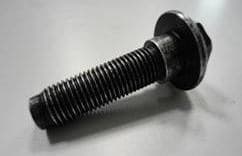
-----
Zinc Plating with Black Passivation comes off during handling
Quickstart:
Fasteners are often zinc plated to protect the steel from corrosion. After plating they are invariably dipped into a tank for chromate conversion coating, a process that protects the zinc from white rust corrosion. If the desired color is black, there are black chromates. But the process involves many additional steps and there are many types of zinc plating processes and many different chromate conversion coating processes.
Q. Dear All,
I am SQA in Auto Industry, I received from my Fastener supplier with some plating defects.
Let me explain in detail .
Zinc Plating, Black Passivation with 8~10 micron thickness.
When we handle the fasteners the black passivation is removing and the same colour was applied on hand during inspection. But not fully.

Need your support.
Regards,
Buyer - India
June 17, 2010
A. Praveen,
Please look out for a better plater.
regards

T.K. Mohan
plating process supplier - Mumbai, India
 I don't find it very helpful when someone writes "find another supplier". It would be more useful to give some suggestions specifically about the plating processes. If I wanted a simple answer I would have Googled it.
I don't find it very helpful when someone writes "find another supplier". It would be more useful to give some suggestions specifically about the plating processes. If I wanted a simple answer I would have Googled it.
- Rome Italy
November 24, 2020
![]()
Hi John,
Praveen asked for "support" and TK's response offered that support, answering his implied question of whether the spec itself, i.e., "Zinc Plating, Black Passivation", was the problem. TK's answer was that the chromate is not supposed to easily rub off that way and the execution, not the spec, is the problem :-)
Praveen is a buyer/customer; the idea that as a customer who has no understanding of the process and hasn't seen it, he will be able to instruct a shop how to fix a problem in that process based on advice from a 3rd party who also hasn't seen it is unfortunately unrealistic.
Now if a plating shop rather than a customer asks such a question, that's a different situation -- and this forum can be very helpful. I suspect that the issue here is that you may be a plater; if so, starting a dialog with TK would probably be quite productive.
T.K. has replied to 223 questions on this site, sometimes following up very helpfully with the inquirer as many as 4 additional times to get facts, situations, and feedback. The causes of plating defects are usually quite complicated, such that T.K. needs a lot of data to get anywhere. The chromate may have been exposed to too high a temperature too soon, but we don't yet know if it's a silver-based chromate or not, a trivalent chromate or not, or if that even happened ... and that's only one possible idea; it could also be the brighteners in the zinc bath being wrong ... and we don't know if the zinc plating was acid, cyanide, or alkaline non-cyanide, and whether it's rack or barrel plating, and whether there is a nitric bright dip between plating and chromating, or a post-dip after chromating, etc. It takes a lot of back & forth to solve such problems, and with a customer who doesn't understand the process as the middleman asking the shop to reveal its process details to the world, it's worse than pulling teeth.
I'm not criticizing your posting, just publicly thanking Mr. Mohan and letting him know how very appreciated his yeoman efforts are. Please review thread 45598 for a good detailed discussion of why chromates rub off, or search the site with the term "chromate rubs off". Best of luck!
Regards,

Ted Mooney, P.E. RET
Striving to live Aloha
finishing.com - Pine Beach, New Jersey
Ted can be retained for immediate
answers or long term project help
Q, A, or Comment on THIS thread -or- Start a NEW Thread
